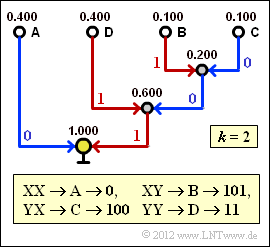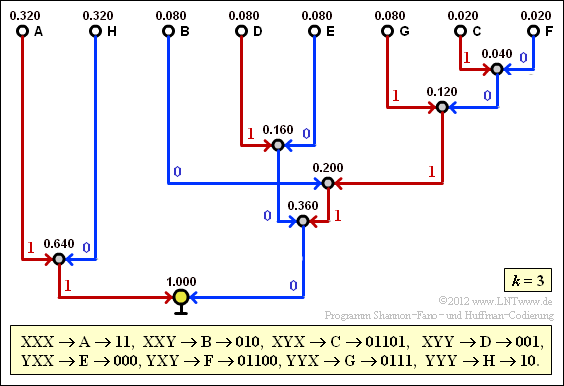Difference between revisions of "Aufgaben:Exercise 2.8: Huffman Application for a Markov Source"
| Line 53: | Line 53: | ||
|type="[]"} | |type="[]"} | ||
- The direct application of Huffman is also useful here. | - The direct application of Huffman is also useful here. | ||
| − | + Huffman makes sense when forming two-tuples $(k = 2)$ | + | + Huffman makes sense when forming two-tuples $(k = 2)$ . |
| − | + Huffman makes sense when forming tuples of three $(k = 3)$ | + | + Huffman makes sense when forming tuples of three $(k = 3)$ . |
Revision as of 20:30, 4 August 2021
We consider the binary symmetric Markov source according to the graph, which is given by the single parameter
- $$q = {\rm Pr}(\boldsymbol{\rm X}\hspace{0.05cm}|\hspace{0.05cm}\boldsymbol{\rm X}) = {\rm Pr}(\boldsymbol{\rm Y}\hspace{0.05cm}|\hspace{0.05cm}\boldsymbol{\rm Y})$$
completely.
- The given source symbol sequences apply to the conditional probabilities $q = 0.2$ bzw. $q = 0.8$, respectively.
- In subtask (1) it has to be clarified which symbol sequence – the red or the blue one – was generated with $q = 0.2$ and which with $q = 0.8$ .
The properties of Markov sources are described in detail in the chapter Message Sources with Memory . Due to the symmetry assumed here with regard to the binary symbols $\rm X$ and $\rm Y$ , some serious simplifications result, as is derived in exercise 1.5Z :
- The symbols $\rm X$ and $\rm Y$ are equally probable, that is, $p_{\rm X} = p_{\rm Y} = 0.5$ holds.
Thus the first entropy approximation is: $H_1 = 1\,\,{\rm bit/source\:symbol}\hspace{0.05cm}. $ - The entropy of the Markov source for $q = 0.2$ as well as for $q = 0.8$ results in
- $$H = q \cdot {\rm log_2}\hspace{0.15cm}\frac{1}{q} + (1-q) \cdot {\rm log_2}\hspace{0.15cm}\frac{1}{1-q} = 0.722\,\,{\rm bit/source\:symbol}\hspace{0.05cm}.$$
- For Markov sources, all entropy approximations $H_k$ with order $k \ge 2$ are determined by $H_1$ and $H = H_{k \to \infty}$ :
- $$H_k = {1}/{k}\cdot \big [ H_1 + H \big ] \hspace{0.05cm}.$$
- The following numerical values again apply equally to $q = 0.2$ and $q = 0.8$ :
- $$H_2 = {1}/{2}\cdot \big [ H_1 + H \big ] = 0.861\,\,{\rm bit/source\:symbol}\hspace{0.05cm},$$
- $$H_3 = {1}/{3} \cdot \big [ H_1 + 2H \big ] = 0.815\,\,{\rm bit/source\:symbol}\hspace{0.05cm}.$$
In this exercise, the Huffman algorithm is to be applied to $k$–tuples, where we restrict ourselves to $k = 2$ and $k = 3$ .
Hints:
- The task belongs to the chapter Entropy coding according to Huffman.
- In particular, reference is made to the page Application of Huffman coding to k-tuples .
- Useful information can also be found in the specification sheets for exercise 2.7 and exercise 2.7Z.
- To check your results, please refer to the interaction module Huffman and Shannon–Fano––coding.
Questions
Solution
- In the blue source symbol sequence 2 one recognizes much less symbol changes than in the red sequence.
- The symbol sequence 2 was generated with the parameter $q = {\rm Pr}(\boldsymbol{\rm X}\hspace{0.05cm}|\hspace{0.05cm}\boldsymbol{\rm X}) = {\rm Pr}(\boldsymbol{\rm Y}\hspace{0.05cm}|\hspace{0.05cm}\boldsymbol{\rm Y}) = 0.8$ and the red symbol sequence 1 with $q = 0.2$.
(2) Answers 2 and 3 are correct.:
- Since here the source symbols $\rm X$ and $\rm Y$ were assumed to be equally probable, the direct application of Huffman makes no sense.
- In contrast, one can use the inner statistical bonds of the Markov source for data compression if one forms $k$–tuples $(k ≥ 2)$.
- The larger $k$ is, the more the mean codeword length $L_{\rm M}$ approaches the entropy $H$.
(3) The symbol probabilities are $p_{\rm X} = p_{\rm Y} = 0.5$, which gives us for the two-tuples.:
- $$p_{\rm A} \hspace{0.2cm} = \hspace{0.2cm} {\rm Pr}(\boldsymbol{\rm XX}) = p_{\rm X} \cdot {\rm Pr}(\boldsymbol{\rm X}\hspace{0.05cm}|\hspace{0.05cm}\boldsymbol{\rm X}) = 0.5 \cdot q = 0.5 \cdot 0.8 \hspace{0.15cm}\underline{ = 0.4} \hspace{0.05cm},$$
- $$p_{\rm B} \hspace{0.2cm} = \hspace{0.2cm} {\rm Pr}(\boldsymbol{\rm XY}) = p_{\rm X} \cdot {\rm Pr}(\boldsymbol{\rm Y}\hspace{0.05cm}|\hspace{0.05cm}\boldsymbol{\rm X}) = 0.5 \cdot (1-q)= 0.5 \cdot 0.2 \hspace{0.15cm}\underline{ = 0.1} \hspace{0.05cm},$$
- $$p_{\rm C} \hspace{0.2cm} = \hspace{0.2cm} {\rm Pr}(\boldsymbol{\rm YX}) = p_{\rm Y} \cdot {\rm Pr}(\boldsymbol{\rm X}\hspace{0.05cm}|\hspace{0.05cm}\boldsymbol{\rm Y}) = 0.5 \cdot (1-q)= 0.5 \cdot 0.2 \hspace{0.15cm}\underline{ = 0.1} \hspace{0.05cm},$$
- $$p_{\rm D} \hspace{0.2cm} = \hspace{0.2cm} {\rm Pr}(\boldsymbol{\rm YY}) = p_{\rm Y} \cdot {\rm Pr}(\boldsymbol{\rm Y}\hspace{0.05cm}|\hspace{0.05cm}\boldsymbol{\rm Y}) = 0.5 \cdot q = 0.5 \cdot 0.8\hspace{0.15cm}\underline{ = 0.4} \hspace{0.05cm}.$$
(4) Opposite screen capture of the (earlier) SWF program Shannon–Fano– and Huffman–coding shows the construction of the Huffman code for $k = 2$ with the probabilities just calculated.
- Thus, the mean codeword length is:
- $$L_{\rm M}\hspace{0.01cm}' = 0.4 \cdot 1 + 0.4 \cdot 2 + (0.1 + 0.1) \cdot 3 = 1.8\,\,{\rm bit/two-tuple}$$
- $$\Rightarrow\hspace{0.3cm}L_{\rm M} = {L_{\rm M}\hspace{0.01cm}'}/{2}\hspace{0.15cm}\underline{ = 0.9\,{\rm bit/source\:symbol}}\hspace{0.05cm}.$$
(5) Correct is the suggested solution 2:
- According to the source coding theorem $L_{\rm M} ≥ H$ holds.
- However, if we apply Huffman coding and disregard ties between non-adjacent symbols $(k = 2)$, the lower bound of the codeword length is not $H = 0.722$, but $H_2 = 0.861$ (the addition bit/source symbol is omitted for the rest of the task).
- The result of subtask (4) was $L_{\rm M} = 0.9.$
- If an asymmetric Markov chain were present and in such a way that for the probabilities $p_{\rm A}$, ... , $p_{\rm D}$ the values $50\%$, $25\%$ and twice $12.5\%$ would result, then one would come to the average code word length $L_{\rm M} = 0.875$.
- How the exact parameters of this asymmetrical Markov source look, however, is not known even to the task creator (G. Söder).
- Nor how the value $0.875$ could be reduced to $0.861$ . In any case, the Huffman algorithm is unsuitable for this.
(6) With $q = 0.8$ and $1 - q = 0.2$ we get:
- $$p_{\rm A} \hspace{0.2cm} = \hspace{0.2cm} {\rm Pr}(\boldsymbol{\rm XXX}) = 0.5 \cdot q^2 \hspace{0.15cm}\underline{ = 0.32} = p_{\rm H} = {\rm Pr}(\boldsymbol{\rm YYY})\hspace{0.05cm},$$
- $$p_{\rm B} \hspace{0.2cm} = \hspace{0.2cm} {\rm Pr}(\boldsymbol{\rm XXY}) = 0.5 \cdot q \cdot (1-q) \hspace{0.15cm}\underline{ = 0.08}= p_{\rm G} = {\rm Pr}(\boldsymbol{\rm YYX}) \hspace{0.05cm},$$
- $$p_{\rm C} \hspace{0.2cm} = \hspace{0.2cm} {\rm Pr}(\boldsymbol{\rm XYX}) = 0.5 \cdot (1-q)^2\hspace{0.15cm}\underline{ = 0.02} = p_{\rm F}= {\rm Pr}(\boldsymbol{\rm YXY}) \hspace{0.05cm},$$
- $$p_{\rm D} \hspace{0.2cm} = \hspace{0.2cm} {\rm Pr}(\boldsymbol{\rm XYY}) = 0.5 \cdot (1-q) \cdot q \hspace{0.15cm}\underline{ = 0.08} = p_{\rm E} = {\rm Pr}(\boldsymbol{\rm YXX})\hspace{0.05cm}.$$
(7) The screen capture of the of the (earlier) SWF program Shannon–Fano– and Huffman–coding coding illustrates the constellation of the Huffman code for $k = 3$. This gives us for the mean codeword length:
- $$L_{\rm M}\hspace{0.01cm}' = 0.64 \cdot 2 + 0.24 \cdot 3 + 0.04 \cdot 5 = 2.52\,\,{\rm bit/three tupel}\hspace{0.3cm} \Rightarrow\hspace{0.3cm}L_{\rm M} = {L_{\rm M}\hspace{0.01cm}'}/{3}\hspace{0.15cm}\underline{ = 0.84\,{\rm bit/source\:symbol}}\hspace{0.05cm}.$$
- One can see the improvement over subtask (4).
- The bound $k = 2$ valid for $H_2 = 0.861$ is now undercut by the mean codeword length $L_{\rm M}$ .
- The new bound for $k = 3$ is $H_3 = 0.815$.
- However, to reach the source entropy $H = 0.722$ (or better: to come close to this final value up to an $ε$ ), one would have to form infinitely long tuples $(k → ∞)$.


